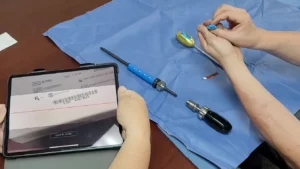
Pedicle screws are a critical component in spinal fusion surgeries, providing the necessary stabilization to aid in the fusion of vertebrae. However, one complication that can arise is the loosening of these screws. Understanding what causes pedicle screws to loosen is essential for both patients and healthcare providers to mitigate risks and improve surgical outcomes.
What Causes Pedicle Screws to Loosen? Reasons
Poor Bone Quality
One of the primary reasons pedicle screws loosen is poor bone quality. Conditions like osteoporosis significantly reduce bone density and strength, making it difficult for the screws to hold firmly. As the bone weakens, it can no longer support the hardware, leading to loosening over time¹⁻².
Improper Screw Placement
Accurate placement of pedicle screws is crucial. Improper targeting or placement can result from various factors, including inexperienced surgeons or inadequate imaging techniques. Even minor deviations in placement can lead to significant issues as the screws fail to achieve proper purchase in the bone³⁻⁴.
High-Impact Activities
Post-surgery, engaging in high-impact physical activities can place excessive stress on the screws, causing them to loosen. Activities that involve heavy lifting or intense bending and twisting of the spine should be avoided to prevent undue strain on the surgical hardware²⁻³.
Poor Healing and Fusion
Successful spinal fusion requires the bone graft to integrate fully with the vertebrae, forming a single, solid bone. In cases where the fusion does not occur correctly, known as failed fusion or pseudoarthrosis, the lack of support can cause the screws to loosen. Factors such as smoking, diabetes, and the patient’s overall health can influence the healing process and the success of the fusion²⁻⁴.
Device and Material Issues
The design and material of the screws can also impact their stability. Screws with inappropriate thread design, length, or diameter may not achieve the necessary hold. Additionally, material defects or degradation over time can lead to screw failure. It’s essential to use screws that are compatible with the patient’s bone quality and anatomical considerations⁴⁻⁵.
Anatomical and Patient-Specific Factors
Anatomical variations, such as atypical vertebral shapes or sizes, and spinal deformities like scoliosis can complicate the placement and stability of pedicle screws. Patient-specific factors, including age and underlying health conditions, also play a role in the likelihood of screw loosening¹⁻².
What Causes Pedicle Screws to Loosen? Conclusion
Pedicle screw loosening is a multifaceted issue influenced by bone quality, surgical technique, patient activity, and device characteristics. Careful preoperative planning, precise surgical techniques, and appropriate postoperative care are crucial to minimize the risk. For more detailed insights, you can read further on How to Fix Loose Pedicle Screws.
References ( What Causes Pedicle Screws to Loosen? )
- “Pedicle screw loosening: the value of radiological imagings and the identification of risk factors assessed by extraction torque during screw removal surgery.” Journal of Orthopaedic Surgery and Research. Retrieved from BiomedCentral.
- “7 Symptoms of Loose Screws After Spinal Fusion Surgery.” New York City Spine. Retrieved from NYC Spine.
- “Symptoms of Loose Screws After Spinal Fusion.” Premia Spine. Retrieved from Premia Spine.
- “Pedicle Screws for Spinal Fusion.” Spine Info. Retrieved from Spine Info.
- “Computational model predicts risk of spinal screw loosening in patients.” European Spine Journal. Retrieved from Springer.



